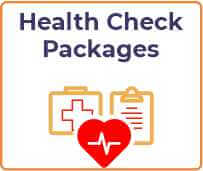What is VQ Scan (Lung Ventilation and Lung Perfusion Scan)?
The VQ scan is a type of lung imaging test that measures both the amount of air in your lungs (ventilation) and how well your blood vessels are bringing oxygen to your lungs (perfusion). The VQ scan provides doctors with information about how well your lungs are working. It can detect or diagnose lung problems such as pneumonia, asthma, pulmonary embolism, congestive heart failure, and COPD (Chronic Obstructive Pulmonary Disease).
The majority of people who have had a VQ Scan (Lung Ventilation And Lung Perfusion Scan) in the past will usually not experience any side effects. The test results provide information about how well the lungs perform their breathing function. This information can help doctors diagnose and treat diseases that affect the lungs.
Feeling difficult to breathe? Book a VQ Scan at Yashoda Hospitals. Performed by highly trained medical personnel, we offer 100% precision in results.
Frequently Asked Questions:
What is VQ Scan (Lung Ventilation and Lung Perfusion Scan) used for?
A VQ scan is a medical test that can measure lung ventilation and lung perfusion. It is commonly used in patients with respiratory failure to determine how well their lungs function. A VQ scan can also be performed on healthy people with certain conditions such as asthma, COPD, pneumonia, or heart failure.
Why do I need VQ Scan (Lung Ventilation and Lung Perfusion Scan)?
A VQ Scan can help you better understand what is happening with your respiratory system to know whether you should take action. It detects pulmonary embolism, pneumonia, or other medical conditions. VQ scans are non-invasive procedures that provide a quick and accurate diagnosis without the need for anesthesia or radiation exposure. They also help to reduce the risks of complications in patients with chronic lung diseases such as emphysema.
What happens during VQ Scan (Lung Ventilation and Lung Perfusion Scan)?
A patient breathes in and out for about 10 minutes during the VQ Scan while breathing into a tube connected to an airflow meter. The machine then calculates how much oxygen is in the blood. This is called the ventilation-perfusion ratio (V/Q). A low V/Q indicates not enough oxygen getting into your lungs while you're breathing in, which could indicate disease or injury in other parts of your body.
What does a ventilation-perfusion VQ scan demonstrate?
A ventilation-perfusion VQ scan demonstrates how well your lungs are working. It's a way to measure how much oxygen is getting into your lungs and how much carbon dioxide is leaving your body and help determine if they are functioning properly. This type of scan is often used in cases where pulmonary embolisms, pneumonia, and other lung conditions impact oxygen levels.
Can a VQ scan detect lung disease?
This is one of the most commonly asked questions in the medical field. While many factors can affect how well this test works, it can be used as a screening tool for the early detection of lung diseases in people with chronic respiratory problems. A VQ scan finds out whether or not someone has lung disease, but it cannot diagnose it. It gives you information about the type of lung disease you have and the severity of the condition.
What is the most common pulmonary perfusion abnormality?
The most common pulmonary perfusion abnormality is right ventricular failure. It is the most common cause of hypoxia in patients with acute respiratory failure. Right ventricular failure is usually caused by severe chronic obstructive pulmonary disease (COPD) or acute respiratory distress syndrome (ARDS). In the case of COPD, the right ventricle becomes progressively less effective and fails to pump blood effectively. In ARDS, there is a breakdown in the lung's ability to oxygenate the blood.
What is a normal VQ ratio?
VQ ratio is the normal resting heart rate in beats per minute, which is calculated by dividing the volume of blood pumped out by the volume of blood pumped in per minute. The normal VQ ratio for a healthy adult is around 4/5 or 0.8. If you have a high VQ ratio, it means that your heart has to work harder to pump enough blood through your veins and arteries. This could mean that you are at risk for developing coronary artery disease or heart failure.
What causes low VQ?
The major cause of low VQ is poor respiratory mechanics caused by airway obstruction, emphysema, or bronchitis. Other causes may include:
- High Altitude: Low oxygen levels at high altitudes can cause low VQ.
- Smoking: Low oxygen levels caused by smoking can also cause low VQ.
- Exercise: After exercising, the lungs must work harder to get more oxygen in the body, leading to low VQ.
Can I drive after a VQ scan?
Yes. In India, driving after a VQ scan is legal if you are not under the influence of alcohol or drugs. In some countries, such as France, driving after a VQ scan is illegal.
What is used for a VQ scan?
VQ scan is done with spirometry. A spirometer has an attached mouthpiece and an inflatable cuff around the chest. Inhaling into the mouthpiece, you blow into the cuff to inflate it to certain pressure (usually 30-60 cm H2O). The pressure in your lungs then pushes air out through the mouthpiece.
References:
-
Mirza, H., & Hashmi, M. F. (2020). Lung Ventilation Perfusion Scan (VQ Scan). StatPearls [Internet].
- Fielding, P. A., Morley, N. C., & Bradley, K. M. (2020). Beware COVID-19 on VQ scans (ventilation/perfusion scintigraphy). QJM: An International Journal of Medicine, 113(12), 892-893.
-
Kember, P. G., Euinton, H. A., & Morcos, S. K. (1997). Clinicians’ interpretation of the indeterminate ventilation-perfusion scan report. The British journal of radiology, 70(839), 1109-1111
Why Choose Yashoda Hospitals
Yashoda Hospitals is committed to providing world-class treatment for patients from across the globe. With the unique combination of state-of-the-art technology, intuitive care, and clinical excellence, we are the healthcare destination for thousands of international patients in India.

On the journey to good health, we understand that it is important for you to feel at home. We plan out all aspects of your trip.

Experienced specialists perform non-invasive and minimally invasive surgeries to provide the best treatment for international patients.

Our hospitals are equipped with advanced technology to perform a wide range of procedures and treatments.

We deliver excellence by delivering quick and efficient healthcare and through pioneering research that helps all our future.patients.










